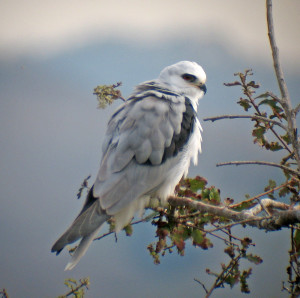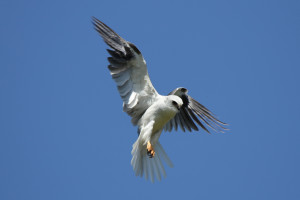Elanus leucurus
Natural History

Image Courtesy of K Schneider
The white-tailed kite is a medium-sized raptor which makes its home in the meadows, grasslands, and oak savannahs ranging from from Oregon to central America. Within the Los Padres National Forest, these birds live everywhere from meadows on coastal bluffs to the pastures at the edge of the central valley. It nests primarily in trees at the edge of forest boundaries and during the non-breeding season they are communal roosters, with roosts of up to 100 birds. During the breeding season, both males and females will participate in choosing and building the nest. The female typically lays four eggs and incubates them for about a month. The parents will then provide care for a little over a month afterwards.
White-tailed kites are named for their unique hunting behavior. These raptors will hover about 80 ft above ground and then drop nearly vertical down onto their prey. They are able to steadily hover while flapping their wings by flying into the oncoming wind, a practice that has come to be called kiting.
Threats
While the white-tailed kite is labelled as “least concern” on the IUCN Red List, they are listed as a fully protected species in California. In the early 20th century, many raptor populations underwent a steep decline due to hunting and egg collecting. Coupled with prey habitat disappearing to agricultural use or grazing land, the white-tailed kite doesn’t have much suitable habitat left within southern California.
Conservation

Courtesy of Jason Crotty
Because of the white-tailed kite’s status as a fully protected species, the grasslands that they rely on are now listed as critical habitat and are well-protected. Additionally, conservation biologists have had great success in setting aside pasture and allowing them to return to grassland, which greatly benefits not only white-tailed kites, but a substantial number of other raptors as well. ForestWatch will continue to fight overgrazing on our public lands to ensure that grasslands remain to support the white-tailed kites and other raptors that depend on them.






